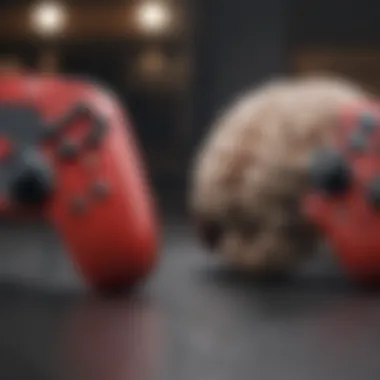Comparative Analysis of Brain Training Games on Nintendo Switch


Intro
The realm of gaming has evolved significantly in recent years, with various genres gaining attention for their potential cognitive benefits. Among these, brain training games, especially those available on the Nintendo Switch, have garnered interest from players of all ages. This article aims to dissect and analyze the landscape of these games, evaluating their effectiveness in enhancing mental functions. The Nintendo Switch presents a unique platform for such endeavors, combining portability with engaging gameplay. As we progress, the exploration will address how these games function, what scientific evidence supports them, and how players can choose the most suitable titles for their mental exercise needs.
Game Feature Spotlight
When evaluating brain training games on the Nintendo Switch, several key features emerge. The analysis of these features sheds light on what differentiates one game from another in terms of player engagement and cognitive enhancement.
Unique Gameplay Mechanics
Each brain training game implements its own gameplay mechanics that contribute to the cognitive development of players. For instance, Brain Age: Nintendo Switch Edition emphasizes quick problem-solving and critical thinking through a series of mini-games. In contrast, Big Brain Academy: Brain vs. Brain focuses on competitive gameplay, allowing players to challenge one another while honing their mental skills.
These mechanics not only create variety but also ensure that players can engage with different types of challenges, further enhancing their cognitive abilities. Studies suggest that diverse cognitive tasks can improve overall brain function more effectively than homogenous tasks.
Art Style and Design
Visual elements play a vital role in player engagement. Brain training games on the Nintendo Switch often feature vibrant colors and engaging fonts, designed to maintain the player's interest. For example, the aesthetic of Dr. Kawashima's Brain Training combines simplicity with functionality, making it appealing yet straightforward.
Though visual style may seem secondary, it contributes significantly to immersing players in gameplay, which is essential for sustained mental exercise. The balance between aesthetics and functionality in design can influence the overall enjoyment of brain training games.
Storyline and Characters
While many brain training games may not prioritize deep storylines or character development, a few titles introduce engaging narratives that enhance user experience. For instance, Professor Layton's Mystery Journey integrates puzzles within a storyline context, compelling players to engage more with the gameplay. The characters evoke a sense of connection, encouraging players to persist in their mental challenges and enjoy the process of learning.
"Engaging narratives can provide context for gameplay, making cognitive exercises feel more like a journey than chores."
The End
In summary, the unique gameplay mechanics, artistic design, and narrative elements define the numerous brain training games available on the Nintendo Switch. As this analysis continues, we will further investigate user engagement, scientific validation, and overall impacts of these games on cognitive function, providing readers with a detailed view of what constitutes effective mental exercise in the gaming world.
Overview of Brain Training
Brain training games have gained significant traction in recent years, capturing the attention of both casual and dedicated gamers. These games offer not just entertainment, but also the promise of cognitive enhancement. This section serves as an introduction, setting the stage for a deeper exploration of how brain training games function and their role in mental development.
Definition and Purpose
Brain training games are designed with the intention of improving various cognitive abilities. These may include memory, attention, problem-solving skills, and sometimes even creativity. The basic premise is that regular engagement with these games can lead to measurable improvements in mental performance. The purpose extends beyond mere amusement; it aims to provide tools for players to strengthen their cognitive skills through interactive and engaging methods. Such tools can be particularly beneficial in an age where mental sharpness is increasingly required in both personal and professional life.
Historical Context
The concept of cognitive training is not new. Psychological studies in the 20th century laid the groundwork for understanding how mental exercises can influence brain function. Beginning with simple puzzles and logic games, brain training evolved alongside advancements in technology. The transition to digital platforms like the Nintendo Switch signifies a pivotal moment in accessibility and interactivity. With the Switch, developers have the opportunity to create diverse, engaging content that appeals to broader audiences. The evolution of these games is a reflection of changing attitudes towards mental exercise, as it gains recognition similar to that of physical fitness.
Scientific Consensus on Cognitive Training
The scientific community has varying opinions on the efficacy of brain training games. Some studies suggest that these games can enhance specific cognitive domains. However, critics argue about the transference of skills gained from these games to real-life situations. The consensus is gradually leaning towards recognizing the positive outcomes of brain training, although limitations exist. Many scholars advocate for further research to fully understand the long-term benefits and potential drawbacks. The ongoing debate underscores the importance of distinguishing between mere entertainment and genuine cognitive enhancement when considering these games.
"While cognitive training games show promise, it is crucial to approach them with a balanced perspective, recognizing their potential alongside their limitations."


Nintendo Switch: A Platform for Innovation
Nintendo Switch has emerged as a front-runner in modern gaming consoles, not just for its versatility, but also for how it accommodates a variety of games, including brain training titles. Understanding the significance of the Switch in the context of cognitive enhancement is essential for gamers and developers alike. Its unique hardware capabilities, user-centric design, and extensive game library make it an optimal platform for engaging and effective brain training experiences.
Hardware Features Support Brain Games
The Nintendo Switch is equipped with advanced hardware that is well-suited for brain training games. It features a custom NVIDIA Tegra processor, which enables smooth graphics and fast processing speeds. This is particularly important for games that require quick reflexes and cognitive challenges. The high-definition display adds to the engagement level, making visual elements in games more appealing and interactive.
Additionally, the Joy-Con controllers play a crucial role. They allow for motion sensing, giving developers the ability to incorporate physical actions into cognitive tasks. This blend of physical and mental engagement can enhance the overall experience, leading to better retention and learning outcomes.
- Multiplayer Options: The Switch encourages social interaction, which is vital for brain training. Players can compete with friends or family, adding a layer of motivation.
- Portable Design: The hybrid nature of the Switch allows users to engage in brain training anywhere, making it easier to fit cognitive exercises into their daily routines.
User Experience and Interface Design
The user experience on the Nintendo Switch distinguishes it from many traditional gaming consoles. Its interface is designed to be intuitive, allowing users of all ages to navigate with ease. From the home screen to the game menus, everything is clear and accessible, which is particularly beneficial for older adults who may not be familiar with gaming technology.
The seamless transition between tabletop and handheld modes enhances the user experience. This function allows players to engage in brain training games in their preferred style. Furthermore, the Switch’s touch screen capability offers an additional layer of interactivity. Many brain training games leverage touch mechanics to create engaging puzzles and brain teasers that challenge players effectively.
Diverse Game Library
One of the most compelling features of the Nintendo Switch is its diverse game library. It hosts a variety of brain training titles that cater to different cognitive focus areas. Games such as Brain Age and Dr. Kawashima's Brain Training harness a range of mental tasks from memory exercises to puzzle-solving.
This variety ensures that players can select games that align with their specific interests and cognitive goals. Moreover, the availability of indie titles expands the library further, providing unique and innovative approaches to brain training. Some games even incorporate popular themes or characters, attracting a broader audience and enhancing appeal.
Analysis of Brain vs Brain
The section on Analysis of Brain vs Brain is crucial as it highlights a key title among the brain training games available on the Nintendo Switch. In today’s digital age, brain training games are gaining traction as tools for cognitive improvement. Understanding this title is important for players who seek to sharpen their mental skills while engaging in entertaining gameplay.
Game Overview and Features
Brain vs Brain offers a variety of mini-games designed to challenge and engage players. Each game focuses on specific mental skills, such as memory, logic, and recall. The layout is user-friendly, allowing players to easily select games and access their profiles. One standout feature is the competitive aspect; players can challenge friends or engage in online matches.
The game incorporates a vibrant score board, displaying users' achievements and progress. This not only fosters a competitive atmosphere but also encourages players to continually improve their scores. The visuals are appealing, and the sound effects add to the immersive experience.
Cognitive Focus Areas
The cognitive focus areas in Brain vs Brain are diverse. Each mini-game is designed to target different mental faculties. For instance:
- Memory games help strengthen short-term recall.
- Logic puzzles enhance problem-solving skills.
- Speed challenges improve reaction times.
By addressing various aspects of cognitive function, this game offers a well-rounded mental workout. Users can identify their strengths and weaknesses, allowing for targeted improvement.
Player Engagement Mechanics
Player engagement is a fundamental component of any game, especially brain training titles. Brain vs Brain uses several mechanics to keep players motivated:
- Leaderboards to encourage competition.
- Daily challenges that offer fresh content.
- Rewards for accomplishments, enhancing the sense of achievement.


These elements serve to create an engaging environment, pushing players to return for more, thereby increasing their overall cognitive exposure.
User Community and Feedback
Another important aspect of Brain vs Brain is its user community. Players often share experiences on platforms like Reddit and Facebook. They provide valuable feedback, discussing not only their gameplay experiences but also how the games have impacted their mental acuity.
"The competitive nature of Brain vs Brain has helped me focus better and has improved my logic skills noticeably," says a frequent player.
This direct feedback contributes to a collective knowledge base, allowing prospective players to make informed decisions about engaging with this title. Community opinions can make a big difference in selecting games that ultimately benefit cognitive development.
Through examining Brain vs Brain, players can gain insight into its features, cognitive benefits, engagement strategies, and the community's views, all crucial for assessing its role in their mental exercise regimen.
Other Notable Brain Training Games on Switch
The realm of brain training games on Nintendo Switch extends beyond just a few well-known titles. This section explores the importance of recognizing other notable brain training games, highlighting specific elements that contribute to cognitive benefits and engagement. By examining a variety of alternatives, readers can gain a broader perspective on the options available, ensuring informed choices in pursuing mental exercise.
Contrast with Other Titles
Several brain training games are available on Switch, each offering different approaches to cognitive enhancement. For instance, Big Brain Academy: Brain vs. Brain engages players with a variety of mini-games that assess their cognitive skills in a playful manner. In contrast, Dr Kawashima’s Brain Training emphasizes traditional puzzles and math challenges, which are more linear in their approach to cognitive training. This distinction illustrates how different gameplay mechanics can yield varying cognitive results, allowing players to choose according to their preferences and training objectives.
Unique Selling Points of Competing Games
Each notable title brings unique features to the table, enhancing its appeal. Lumosity, known for its extensive user base, employs scientifically-backed game design tailored for improving memory and attention. Another title, Elevate, focuses on personalized learning experiences, adapting challenges to the user's needs and progress. The interactive nature of these games encourages users to engage consistently, which is fundamental to realizing cognitive improvements. Additionally, the social dimensions of these games, like leaderboards and multiplayer modes, foster a sense of competition and community, making the experience even more enriching.
Comparative Analysis of Game Performance
To effectively evaluate the performance of these brain training games, it's essential to consider various factors, including user engagement, feedback, and overall effectiveness in enhancing cognitive function. Games like Brain Age and Peak receive high marks for user retention and engagement metrics. On the other hand, titles such as Fit Brains excel in delivering diverse exercises that capture users' interest over time. By assessing these performance indicators, players can determine which games best align with their personal goals for mental exercise.
"Understanding the nuances of different brain training games is vital for maximizing cognitive benefits and enjoying the process of learning."
Scientific Research on Effectiveness
Understanding the scientific research behind brain training games is vital. It allows us to gauge their effectiveness in enhancing cognitive functions. This section explores documented benefits, the limitations within the existing body of research, and potential future avenues for study.
Cognitive Benefits Documented in Studies
Various studies have shown that brain training games can lead to cognitive improvements. Common areas of enhancement include memory, problem-solving, and processing speed. A notable study by the Proceedings of the National Academy of Sciences indicates that players who engaged in targeted brain training exhibited marked improvement in tasks requiring attention and working memory. Such benefits suggest that consistent engagement with these games could offer real cognitive gains.
Moreover, games like Brain Age have been associated with improved performance in everyday mental tasks. Players often report feeling sharper and more alert after regular use. The reported boost in cognitive flexibility signals the potential for these games to aid in complex problem-solving situations, thereby benefiting daily life.
Limitations of Existing Research
Despite promising findings, the current research has significant limitations. Many studies rely on small sample sizes, undermining the generalizability of results. Additionally, the methodology employed often lacks rigour. Some studies assess short-term outcomes without tracking long-term cognitive changes. This raises questions about whether cognitive improvements persist after ceasing gameplay.
Furthermore, the validity of measuring cognitive benefits through games without a control group complicates results. Studies such as those published in Psychological Bulletin highlight the need for refined approaches.
An over-reliance on self-reported data also introduces bias. Users may perceive benefits that are not objectively measurable.


Future Directions in Research
To fully understand the impact of brain training games, future research should focus on several key areas. Larger, more diverse sample groups are essential to establish a clearer correlation between gameplay and cognitive improvement. Longer studies could help determine if the benefits of brain training games are enduring.
Incorporating advanced neuroimaging techniques may provide insights into the brain activity changes associated with gameplay. Such methods could reveal the specific cognitive processes engaged during these activities.
Moreover, exploring the differences in impact based on age groups could yield valuable information. Results might differ across demographics, which would be important for tailoring games to maximize their cognitive benefits.
Research indicates that brain training games can improve cognitive functions, but more rigorous studies are essential to confirm long-lasting effects.
By pursuing these research directions, we can deepen our understanding of how brain training games contribute to cognitive enhancement. This is crucial for optimizing these games' development and effectiveness.
User Experience and Recommendations
User experience plays a crucial role in determining the effectiveness of brain training games on the Nintendo Switch. These games are designed to enhance cognitive functions, but how users navigate their environment and engage with the content can significantly influence outcomes. When assessing these titles, it is essential to understand various aspects such as interface design, accessibility, and player feedback. Recommendations can help users maximize their experience and benefits from these cognitive tools.
Navigating the Game Environment
An intuitive game environment is vital for user engagement. Players should be able to navigate menus, select options, and understand gameplay mechanics with ease. A complicated interface can lead to frustration, causing users to abandon potential benefits of the game. Many brain training games on the Switch have simplified navigation features, ensuring that users of all ages can access them. Clear labels, responsive controls, and tutorial guides enhance the user experience.
Additionally, designed layouts keep distractions minimal, allowing players to focus on cognitive tasks. If the game includes challenges that require quick reactions or strategic thinking, a seamless environment increases the likelihood of prolonged engagement. Thus, developers ought to prioritize user-friendly designs while also incorporating feedback mechanisms for continuous improvement.
Balancing Fun and Cognitive Challenge
The effectiveness of brain training games hinges on a delicate balance between enjoyment and cognitive demands. While the primary goal is enhancement of mental faculties, it's crucial that the gameplay remains stimulating and enjoyable. If a game is too simplistic, users may feel unchallenged and disengaged. Conversely, excessive difficulty can lead to frustration, negating the benefits of cognitive training.
Many successful titles employ adaptive difficulty settings, allowing the game to adjust based on user performance. This feature ensures that players remain engaged without feeling overwhelmed. The combination of fun elements—such as rewarding animations, engaging narratives, and appealing graphics—can elevate user experience. Players are more likely to stick with their training when they enjoy the process itself.
Tips for Maximizing Benefit from Brain Games
To get the most out of brain training games, consider the following practical tips:
- Set Clear Goals: Establish what you hope to achieve through gameplay. Whether it's improving memory or enhancing problem-solving skills, having clear objectives can guide your experience.
- Regular Play: Consistency is key in cognitive training. Aim to engage with the games regularly rather than in sporadic sessions. Short daily playtimes can be more effective than longer sessions spread out over time.
- Track Progress: Many games come with built-in progress tracking features. Utilize these tools to monitor your improvement. This knowledge can serve as motivation and also help direct your focus to weaker areas.
- Experiment with Different Games: Not all brain training games are equal. Trying a variety can help you find the games that resonate with you and fit your cognitive goals.
- Create a Conducive Environment: Play in a calm and quiet place to minimize distractions. Focus is essential for meaningful cognitive progress.
"While brain training games can be entertaining, the real value comes from integrating them into your routine effectively."
Following these recommendations can enhance the likelihood of achieving cognitive improvements through games on the Nintendo Switch. By emphasizing user experience, balancing enjoyment with challenge, and engaging deliberately, gamers can cultivate a productive and enjoyable cognitive training regimen.
Culmination and Future Perspective
The topic of brain training games on the Nintendo Switch holds significant relevance. As technology evolves, it reshapes our interaction with cognitive exercises. This article aims to unravel various dimensions of brain training games. Key aspects include their effectiveness, user engagement, and how they fit into the larger gaming ecosystem.
Summarization of Findings
Through the analysis of different brain training games, several critical findings emerge. The games vary not only in the cognitive tasks they offer, but also in user experience and engagement levels. For instance, Brain vs Brain provides interactive multiplayer options, while Dr Kawashima's Brain Training focuses on individual mental activities. Both games emphasize distinct cognitive skills: memory, problem-solving, and speed of thought.
Moreover, scientific studies reveal some cognitive benefits of these games. They show potential improvements in working memory and attention spans. However, the evidence is not entirely conclusive, indicating the need for further investigation. The diversity in game mechanics highlights that user preference plays a vital role in the effectiveness of brain training.
The Role of Brain Games in Modern Gaming Culture
In today's gaming culture, brain games occupy a unique place. They bridge the gap between entertainment and education. Players now seek not only to enjoy leisure time but also to improve their mental faculties. This demand is particularly reflected in the increasing popularity of brain training titles on platforms like the Nintendo Switch.
These games encourage a proactive approach to cognitive health. They appeal to a broad demographic, attracting players of all ages. A mix of fun and challenge is essential to engage users meaningfully. As a result, brain training games are reshaping gaming norms, making cognitive improvement an attractive gaming goal.







